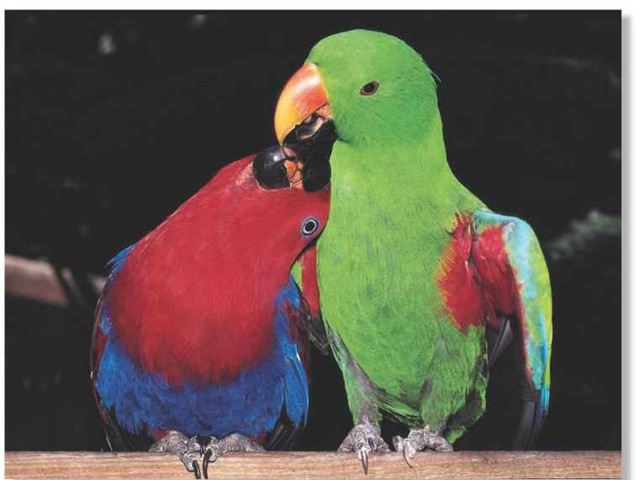ORDER
Psittaciformes
FAMILY
Psittacidae
GENUS & SPECIES
KEY FEATURES
Eye-catching in scarlet and violet-blue, the female is very different from the green male Feasts on rainforest fruits and nuts, aided by its powerful yet sensitive bill More often heard than seen, despite its color and abundance, as it lives high in the canopy
WHERE IN THE WORLD?
In parts of Southeast Asia, from the Sunda Strait in the west to the Solomon Islands, including New Guinea; also found in northeastern Australia
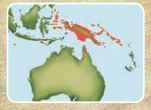
Lifecycle
Rainbow-colored parties of eclectus parrots move through the rainforest in search of food, yet they’re elusive residents of the treetops and quickly fly off when disturbed.
HABITAT
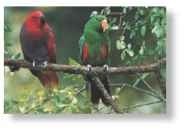
A Canopy couple
The eclectus is often seen 100′ or more up in the trees.
Preferring rainforest-covered lowlands of islands in Southeast Asia, the eclectus parrot rarely lives higher than altitudes of 3,300′. It also inhabits clearings and open (secondary) forest that has regrown following the felling of the original treecover It’s abundant in coastal areas, including mangroves, plantations and even gardens. As the eclectus parrot feeds, roosts and nests high among the branches of the forest canopy, it usually remains unseen.
BREEDING
In parts of its range, the eclectus parrot may breed throughout the year; but on Cape York Peninsula, Australia, its breeding season is between August and January. A pair develops a strong bond and the male may delicately nibble his mate’s neck before mating, which takes place while both birds perform a duet of loud, bell-like calls.
The female lays two glossy white eggs on the woodchip floor of her deep nesting hole. She incubates them for 26 days, twice a day climbing up to the entrance — which may be up to 20′ above the base of the hole — to be fed by her mate. The young eventually leave the nest after 11 or 12 weeks.
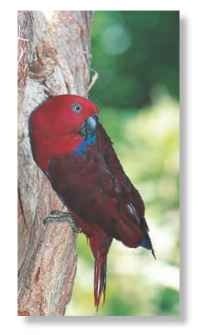
A High-rise The nest hole is high in a deciduous tree trunk.
FOOD & FEEDING

A Juicy fruit
A female devouring figs: a favorite food in the Solomon Islands.
BEHAVIOR
With its range of strident, raucous calls, the eclectus is more often heard than seen. Before dusk, groups of three or four parrots return to their communal roost in noisy procession, males flying ahead of the females. At the roost they’re even noisier and their screeching and squawking may continue after nightfall.
The parrot climbs and hops with agility in the branches and foliage of the treetops. But it flies high over the canopy when it’s alarmed, moving to new feeding grounds or traveling to its roosting site. It flies strongly, but with slow, deliberate wingbeats and often appears dark-colored in flight, an illusion exaggerated by the blackish undersides of its largest wing feathers.
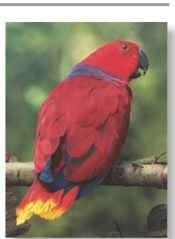
A Hiding its light The green male is seen more often than the female; she must keep to cover to avoid attracting predators.
Main foods of the eclectus are rainforest fruits, seeds, nuts, leaf buds and nectar. As all of the parrot’s range is tropical, with high daytime temperatures all year, there’s always food. In a tree where ripe fruit is abundant, the parrot gathers in flocks of up to 80, but usually feeds in smaller groups. While feeding, the parrots make a soft, flutelike chu-we, chu-we call.
The parrot readily takes advantage of cultivated fruits, which sometimes draws it into populated areas. For example, on Bougainville Island, off the coast of Papua New Guinea, it moves into gardens to feed on sweetcorn, bananas and papaya. Nevertheless, it remains a wary bird and will take flight if disturbed during its meal.
# For 100 years or so, the strikingly different plumages of the male and female eclectus parrot led naturalists to believe that they were two different species.
Adult eclectus parrots with a pair of newly hatched chicks to feed are often helped by offspring of the previous year.
The eclectus parrot is also known as the red-sided parrot, and a local Southeast Asian name for the bird is the “kalunga.”
FOOD FORTHOUGHT
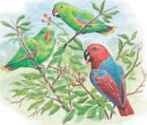
1 Going nuts…
A small group of eclectus parrots busily cracks open ripening seeds in the crown of a rainforest tree.
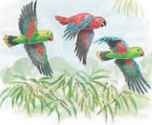
2 Flying colors…
Having exhausted this food supply, the party flies off in search of fresh feeding grounds.
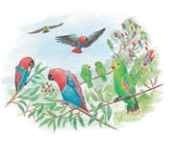
3 Joining in…
From high above the canopy, they spot another feeding party of parrots, which have found nuts.
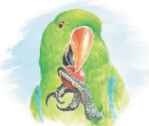
4 Sweet reward
Maneuvering a nut with a dexterous foot, a parrot splits it to reveal its nutritious kernel.
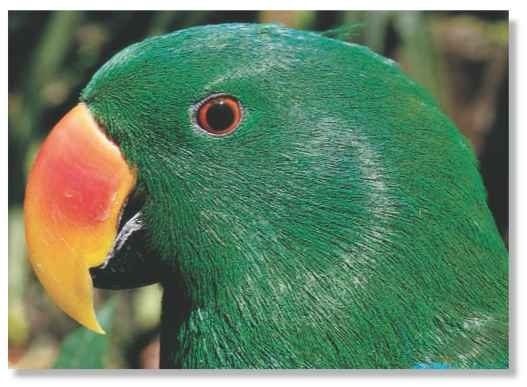
CONSERVATION
Common and even abundant in places, the eclectus parrot faces no serious threats at present. But its long-term
security, like that of all parrots, is ultimately dependent on the preservation of its habitat in the face of loss to logging and clearance for human settlement. In Australia, the eclectus has actually extended its range since first being discovered on the mainland in 1913. It’s now commonly attracted to commercial fruit plantations and even visits gardens.
Profile
Eclectus Parrot
By pairing its strong grasping feet with its sturdy, hooked bill, the eclectus parrot can handle food and clamber among treetop foliage with great skill.
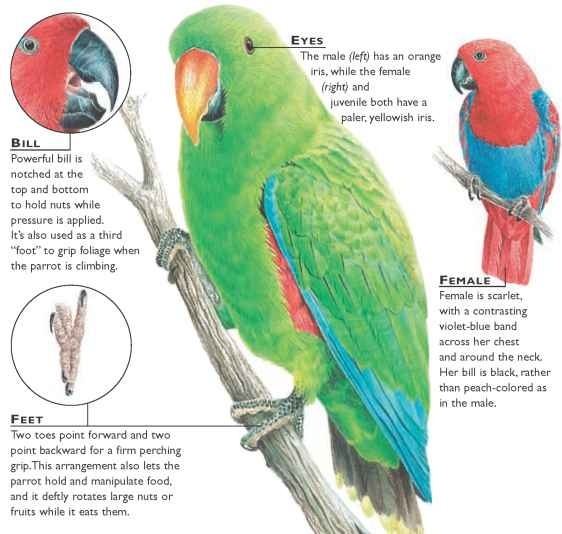
CREATURE COMPARISONS
The eclectus parrot is stouter than its relation the Australian king parrot (Alisterus scapulahs) and weighs twice as much. But like the eclectus, the sexes look quite different.The female is green, except for a crimson belly; the male is also crimson on his breast head and neck with a blue rump and tail.
The Australian king parrot inhabits the Great Dividing Range, which runs from north to south parallel to Australia’s eastern coast, as well as the coastal strip. It’s absent from the only part of the
continent where the eclectus occurs: Cape York Peninsula at the northern tip of Queensland.
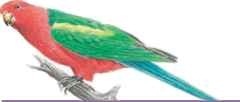
Australian king parrot (male)
| VITAL | |
| STATISTICS | |
| Weight | 14-21 oz. |
| Length | Iplilii |
| Wingspan | 1.5′ |
| Sexual Maturity | Probably 3 or 4 years |
| Breeding Season | All year, peaks Aug.-Jan. in Australia |
| Number of Eggs | 2 |
| Incubation i Period | 26 days |
| Fledging ‘ Period | 72 days |
| Breeding Interval | 1 year |
| Typical . Diet | Fruits, nuts, seeds, leaf buds and nectar |
| Lifespan | 20-30 years |
RELATED SPECIES
• There are 340 species of parrot in 3 families in the order Psittaciformes. The largest family, Psittacidae, includes the buff-faced pygmy 1 parrot, Micropsitta pusio (below), the world’s smallest parrot (3″ long).

